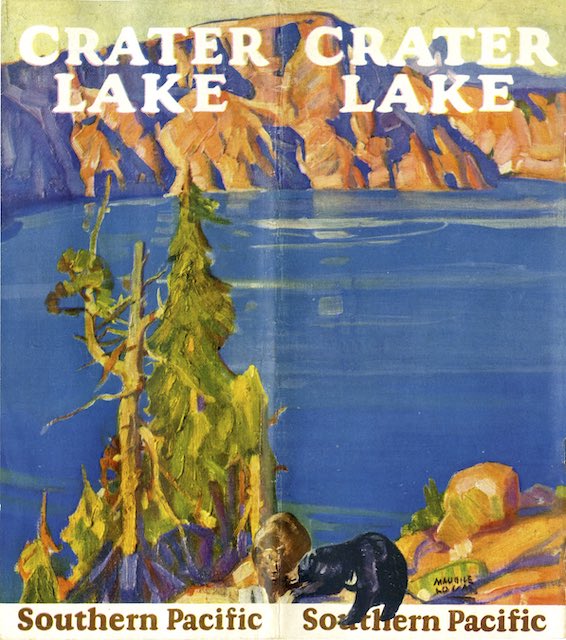“Now you can reach Crater Lake by either Siskiyou Line or new Cascade Line, Shasta Route,” advises this booklet. We’ve previously seen the Maurice Logan painting on the cover (which is the back cover) on a poster. Inside are 20 black-and-white photos along with plenty of descriptive text.
 Click image to download a 6.5-MB PDF of this 16-page booklet.
Click image to download a 6.5-MB PDF of this 16-page booklet.
The booklet is undated, but the “new Cascade Line,” also known as the Natron Cutoff, was opened to traffic in 1927. The names of the agents in the back also match a 1927 timetable, but not 1928, so I feel confident in dating this to 1927.
I’ve been to Crater Lake many times, but I’ve never seen the “Lady of the Woods,” a sculpture in volcanic rock, pictured on page 11. “What was its origin?” the booklet asked. “Is it a freak of nature, or, as has been claimed, was some prehistoric individual overwhelmed by lava and the form of her body recorded in this everlasting pose? The most reasonable theory ascribes this lovely figure to the handiwork of some visiting artist.”
All of those “theories” turn out to be wrong, as the carving was done not by a visiting artist but by a medical doctor in 1917. Dr. Earl Russell Bush (1886-1970) was hired to provide medical care for the crews building the first road around the lake. At the end of construction season, he had a couple of weeks to himself and, though he had never carved anything before, sculpted this figure out of a large rock. The identity of the sculptor was a mystery until Russell revealed himself in 1921, but should have been known to the authors of this booklet in 1927.
The name, “Lady of the Woods,” was given to the sculpture by northwest photographer Fred Kiser. Kiser’s display of Crater Lake photographs at the 1905 Lewis & Clark Exposition persuaded Louis Hill to hire him to photograph the area that would become Glacier Park, which he did for six summers. In 1921, he proclaimed himself the official photographer of Crater Lake National Park after building a studio there (which has since been turned into the visitor center). It is possible that some of the photographs in this booklet are his, but since he was meticulous about copyrights, I suspect not.
